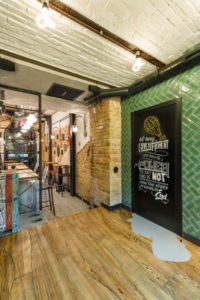The eclectic interior of the gourmet cafe Bite & Go. Deli Cafe in Kiev
 Studio Yaroslav Galant innovative design has completed work on the interior of a gourmet cafe located in the very center of Kiev with exquisite street food Bite & Go. Deli Cafe. The establishment is decorated in the style of smart industrial, created about seven years ago by designer Yaroslav Galant.
Studio Yaroslav Galant innovative design has completed work on the interior of a gourmet cafe located in the very center of Kiev with exquisite street food Bite & Go. Deli Cafe. The establishment is decorated in the style of smart industrial, created about seven years ago by designer Yaroslav Galant.
Smart industrial is a bold eclectic, combining modern materials and technologies, creative adaptation of traditional style elements, and the principles of sustainable design that are relevant in the world: the second life of old objects and materials in a new functional quality, environmental friendliness, respect for the historical value of the environment.
The challenge for the designers was to place a certain number of seats in a narrow and long space. As a result, along with an ergonomic layout, techniques were used that increased the room at the level of sensations.
The authors of the project exposed the original brickwork, left the arched form of the entrance and part of the ceiling. Supporting the architecture of the building, the designers used smooth curves of the lines in the elements of lamps with shades from real ice buckets of the 60s. Glass pendant lamps of the 1890s were used as the main lighting of the hall.
Ceramic insulators found at the recycling factory warehouse, the material of which causes pleasant visual and tactile associations with dishes, and even futuristic shapes, became supports for the tables.
Atmospheric and functional industrial elements – metal columns, open air ducts, external electrical wiring, reinforced glass, cast concrete supports for the sofa.
The undulating floor designed by Yaroslav in the open kitchen area is made of ash and covered with eco-friendly oil-wax, like all other wooden interior elements.
The main part of the open kitchen is made of a Corian artificial stone that contrasts with the decor of the room – a high-tech, hygienic material that repeats the silhouette of ceramic insulators.




